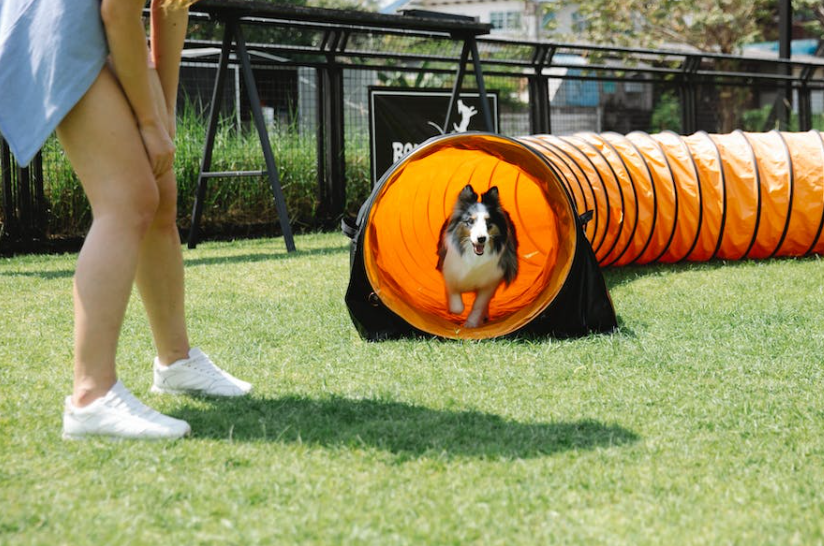
As pet owners, we want nothing but the best for our furry friends. Along with a nutritious diet and regular veterinary care, exercise plays a crucial role in keeping our pets healthy and happy. Just like humans, pets need regular physical activity to maintain their overall well-being. In this article, we will explore the numerous benefits of regular exercise for your pet’s health. From physical fitness and weight management to mental stimulation and behavior control, exercise is an essential part of your pet’s routine that can strengthen the bond between you and your four-legged companion.
Physical Fitness and Weight Management
Regular exercise is essential for your pet’s overall health and well-being. Let’s explore the importance of engaging in activities that get your pet moving and a few of the benefits it provides:
Weight Management
- Regular exercise helps your pet maintain a healthy weight and prevent obesity. Obesity in pets can lead to various health issues such as diabetes, joint problems, and heart disease.
- Physical activity helps burn calories and maintain a healthy metabolism, keeping your pet at an ideal weight. It also helps prevent excessive weight gain and promotes lean muscle development.
Cardiovascular Health
- Exercise promotes a healthy cardiovascular system by increasing heart rate and improving blood circulation. This helps strengthen the heart muscle and reduces the risk of heart disease in your pet.
- Regular aerobic exercise, such as brisk walking or jogging, helps improve endurance and stamina, enhancing your pet’s overall cardiovascular fitness.
Muscle Tone and Strength
- Engaging in activities that involve physical exertion, such as playing fetch, running, or swimming, helps improve muscle tone and strength in your pet.
- Strong muscles provide support to joints and bones, reducing the risk of injuries and improving overall mobility and agility.
Mental Stimulation and Enrichment
Exercise isn’t just about physical health—it also provides mental stimulation and enrichment for your pet. We will explore how activities like puzzle toys, interactive play, and training sessions challenge your pet’s mind, prevent boredom, and promote cognitive development. Mental stimulation is particularly important for intelligent breeds or high-energy pets, as it keeps their minds sharp and prevents destructive behaviors caused by pent-up energy.
Preventing Boredom
- Mental stimulation helps prevent boredom in pets, especially intelligent breeds or high-energy individuals. When pets are bored, they may exhibit destructive behaviors or engage in excessive barking, chewing, or digging.
- Activities that challenge their minds help keep them engaged, satisfied, and less likely to engage in undesirable behaviors.
Cognitive Development
- Engaging your pet in activities that require problem-solving and decision-making helps stimulate their cognitive abilities and promotes mental development.
- Puzzle toys, interactive games, and training sessions encourage your pet to think, learn, and use their problem-solving skills to achieve rewards. This mental exercise enhances their intelligence and can improve their overall behavior and responsiveness.
Behavior Control and Socialization
Regular exercise plays a vital role in behavior control and socialization. Here are some of the benefits of regular exercise for your pets:
Energy Outlet
- Regular exercise provides an outlet for your pet to burn off excess energy. Dogs, in particular, require physical activity to prevent restlessness and boredom, which can lead to destructive behaviors.
- Engaging in activities that promote physical exertion, such as running, playing fetch, or agility training, helps channel your pet’s energy in a positive and productive way.
Alleviating Anxiety and Stress
- Mental stimulation can help alleviate anxiety and stress in pets by redirecting their focus and energy towards engaging activities.
- Challenging their minds with interactive toys or problem-solving tasks can help distract them from anxiety triggers and provide a sense of accomplishment and satisfaction.
Socialization Opportunities
- Exercise presents opportunities for your pet to interact with other pets and humans, promoting socialization and improving their social skills.
- Activities such as dog park visits, group walks, or obedience classes allow your pet to meet and interact with different animals and people, enhancing their social experiences and reducing fear or aggression towards unfamiliar beings.
Bonding and Quality Time
Engaging in physical activities with your pet creates a special bond and strengthens the relationship between you and your furry friend. Let’s delve into the ways exercise fosters bonding:
Quality Time Together
- Exercise provides dedicated time for you and your pet to be present with each other, away from distractions and daily routines.
- Whether it’s going for a walk, playing fetch, or engaging in other physical activities, this shared time strengthens your bond and allows you to focus solely on each other.
Trust and Communication
- Through exercise, you and your pet learn to communicate and understand each other’s cues and body language.
- Training sessions or obedience exercises during exercise routines enhance the trust and cooperation between you and your pet, as they learn to follow commands and respond to your guidance.
Tailoring Exercise to Your Pet’s Needs
Every pet has unique exercise requirements based on factors like age, breed, and health condition. We will provide guidance on tailoring exercise routines to suit your pet’s individual needs. Whether you have a young and energetic pup or a senior pet with specific limitations, we will offer tips on selecting appropriate activities, intensity levels, and durations to ensure a safe and effective exercise routine.
Age Considerations
- Puppies and Kittens: Young pets have boundless energy and require regular exercise to promote healthy growth and development. However, their growing bodies are still developing, so it’s important to avoid excessive high-impact activities that could strain their joints. Shorter bursts of playtime with frequent rest breaks are ideal.
- Adult Pets: Adult pets generally have a consistent energy level. Engage them in moderate to vigorous exercise that suits their breed and activity level. Balance aerobic activities like jogging or playing fetch with mentally stimulating exercises to keep them mentally and physically fit.
- Senior Pets: Older pets may have decreased mobility and energy levels. Choose low-impact exercises such as leisurely walks or gentle play sessions. Be mindful of any age-related health conditions and consult with your veterinarian to determine the most appropriate exercise routine for your senior pet.
Breed Considerations
- High-Energy Breeds: Breeds such as Border Collies, Retrievers, and Terriers require more vigorous exercise to burn off excess energy. Engage them in activities like running, agility training, or interactive play sessions to meet their exercise needs.
- Low-Energy Breeds: Some breeds, like Bulldogs, Basset Hounds, or certain toy breeds, have lower energy levels and may prefer shorter walks or gentle play sessions. Respect their limitations and adjust the intensity and duration of exercise accordingly.
Health Considerations
- Medical Conditions: Pets with certain medical conditions, such as arthritis or heart disease, may require specialized exercise routines. Consult with your veterinarian to develop a suitable exercise plan that accommodates your pet’s condition and limitations.
- Weight Management: If your pet is overweight or obese, exercise plays a crucial role in their weight loss journey. Gradually increase their activity level, focusing on calorie-burning exercises and monitoring their progress closely.
Fun Exercise Ideas and Activities
Keeping your pet motivated and engaged during exercise is essential for their overall well-being. From interactive toys and games to outdoor adventures and even specialized exercise classes, here are some fun exercise ideas and activities to keep them entertained:
Interactive Toys and Games
- Treat-Dispensing Toys: Use puzzle toys or treat-dispensing balls to challenge your pet’s problem-solving skills while providing physical activity.
- Hide and Seek: Hide treats or toys around the house or yard and encourage your pet to find them. This game stimulates their natural hunting instincts and keeps them mentally engaged.
- Tug-of-War: Engage in a gentle game of tug-of-war using a sturdy rope toy. This activity provides physical exercise and strengthens the bond between you and your pet.
Outdoor Adventures
- Nature Walks: Take your dog on leisurely walks in parks or nature trails, allowing them to explore new scents and sights. This activity provides mental stimulation and exposure to different environments.
- Fetch and Frisbee: Play a game of fetch or frisbee in an open space, such as a backyard or dog park. These activities encourage running and jumping, providing cardiovascular exercise for your pet.
- Swimming: If your pet enjoys the water, take them for a swim in a safe and controlled environment. Swimming is a low-impact exercise that is gentle on their joints while providing an excellent workout.
Specialized Exercise Classes
- Agility Training: Enroll your dog in agility classes where they can navigate through obstacle courses, tunnels, and jumps. This activity enhances their physical coordination and mental focus.
- Canine Fitness: Consider joining a canine fitness class that focuses on core strengthening, balance exercises, and coordination. These classes are particularly beneficial for active breeds and dogs recovering from injuries.
Overcoming Exercise Challenges
We understand that incorporating regular exercise into your pet’s routine can come with challenges. We will address common obstacles such as busy schedules, inclement weather, or physical limitations and offer practical tips to overcome them. By finding creative solutions, you can stay committed to your pet’s fitness journey and ensure they reap the benefits of regular exercise.
Busy Schedules
- Set a Schedule: Plan specific times for exercise and make it a non-negotiable part of your daily routine. Consistency is key.
- Divide and Conquer: If your schedule is packed, consider splitting exercise sessions into shorter, more frequent intervals throughout the day.
Inclement Weather
- Indoor Activities: When the weather doesn’t permit outdoor exercise, focus on indoor activities like playing with interactive toys, using puzzle feeders, or practicing obedience training.
- Indoor Agility: Create an obstacle course using household items like cushions, tunnels, and low jumps. This can provide mental and physical stimulation for your pet.
Physical Limitations
- Modify Exercises: Adapt exercises to accommodate any physical limitations your pet may have. For example, shorter or slower walks for senior pets, or low-impact activities like swimming for pets with joint issues.
- Seek Veterinary Advice: Consult with your veterinarian to determine appropriate exercises for pets with specific health conditions or injuries.
Conclusion
Regular exercise is a cornerstone of your pet’s overall health and well-being. By prioritizing physical activity, you can help your pet maintain a healthy weight, stimulate their mind, and prevent behavioral issues. It also helps to strengthen the bond between pet and owner. Remember to consult with your veterinarian to determine the appropriate exercise routine for your pet’s age, breed, and health condition. So, let’s lace up our sneakers, grab our pet’s favorite toys, and embark on a journey of improved health and happiness for our beloved four-legged companions.































